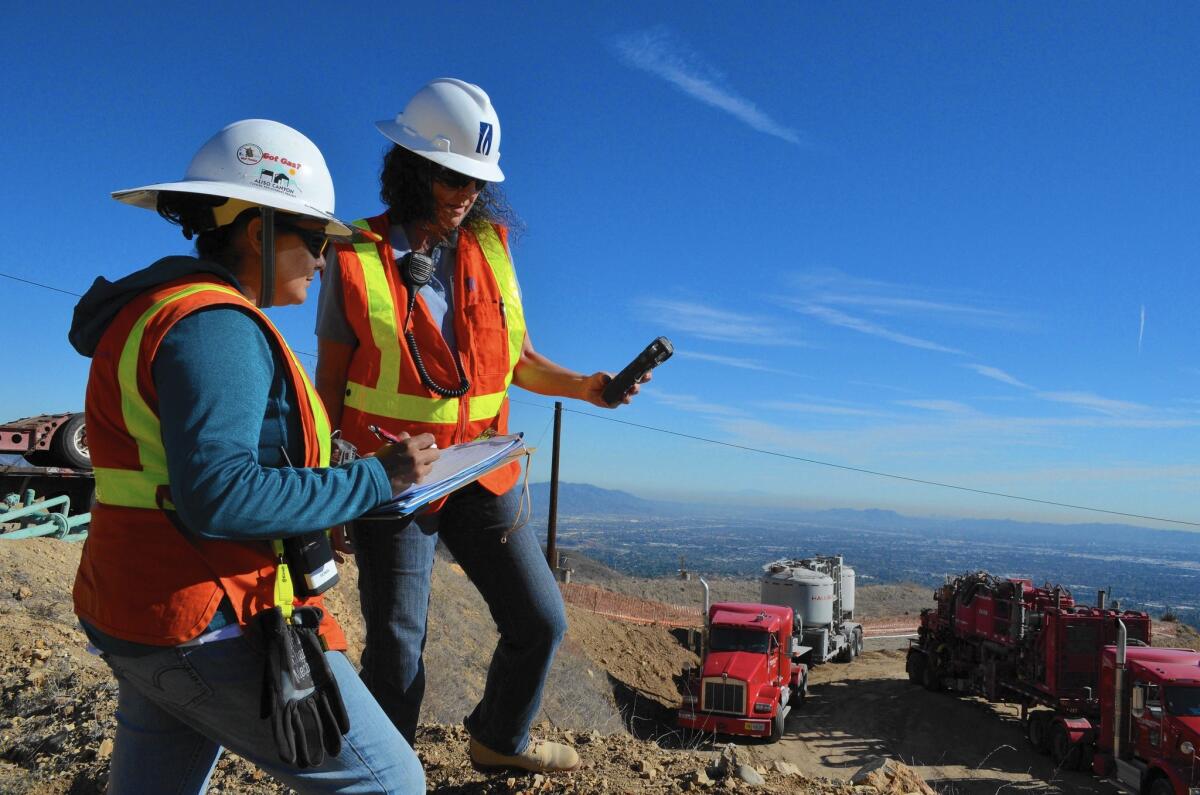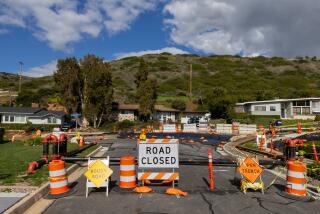Natural gas leak that’s sickening Valley residents could take months to fix

Sonia Rodriguez, left, and Bonnie Feemster take air samples to measure methane leaking from a natural gas pipe near Porter Ranch.
Southern California Gas Co. is warning that it might need several months to plug a natural gas leak that has been sickening residents in the San Fernando Valley for weeks.
A leaking well in the Santa Susana Mountains, more than a mile from the nearest homes in the Los Angeles neighborhood of Porter Ranch, has elicited hundreds of complaints from residents and drawn the scrutiny of state regulators and health officials.
The gas company discovered the leak at its Aliso Canyon storage facility Oct. 23 and said it occurred in a pipe casing a few hundred feet below the surface of a well that goes 8,500 feet underground. The gas is flowing into the earth and seeping up through the ground, said Javier Mendoza, a gas company spokesman.
NEWSLETTER: Get essential California headlines delivered daily >>
On Friday, the California Air Resources Board released a report showing that the well has been leaking a huge amount of methane, the primary component of natural gas and a potent greenhouse gas. Methane is being released at a rate of about 50,000 kilograms per hour, accounting for about one-quarter of all methane emissions in California, the board estimated.
To date, the leak has released the equivalent of 0.80 million metric tons of carbon dioxide, the air board estimates, about the same amount of emissions as driving 160,000 cars for a year or consuming 90 million gallons of gas. The finding “underscores the urgency of stopping the gas leak,” according to the report, which is based on measurements collected on the ground and from towers, airplanes and satellites.
As the leak drags on, patience is wearing thin among Porter Ranch residents, who have reported rotten egg odor, headaches, nausea, dizziness, nosebleeds and other symptoms that have forced some to stay indoors.
The South Coast Air Quality Management District has received 499 odor complaints.
“When the wind blows, it will just blast you and your eyes get watery,” said Paula Cracium, president of the Porter Ranch Neighborhood Council, adding that the leak “keeps going on and on and there doesn’t seem to be any relief in sight.”
“The community is understandably frustrated and up in arms, both from an environmental standpoint and for their quality of life,” Cracium said.
The gas company said that what people are smelling is an odorant that utilities add to natural gas to assist in leak detection. The company has posted information on its website assuring residents that “the leak does not pose an imminent threat to public safety.”
Health officials confirmed that the gas being released is not dangerous and does not pose long-term health risk. But mercaptans, the sulfur-like odorants added to natural gas, can cause the short-term health problems being reported.
Those symptoms “are expected to continue, as long as the odors remain,” according to an assessment by the L.A. County Department of Public Health, which Thursday ordered the company to pay to relocate residents affected by the odors.
On Friday, the Los Angeles City Council approved a motion by Councilman Mitchell Englander summoning the gas company, environmental regulators and fire and health officials to answer questions.
Air district inspectors on Nov. 5 ordered the gas company to stop the leak “safely and as soon as possible.”
“We’re currently evaluating the complaints and the information provided by the gas company to determine if any violations have occurred,” air district spokesman Sam Atwood said.
Samples collected by the air district in residential areas found elevated levels of methane, ethane and propane, gases that are not considered toxic. In front of one house, the air district detected methane at 616 parts per million — far above typical background levels of 2 ppm. Another sample had elevated levels of benzene, a carcinogen.
Gas company crews have tried unsuccessfully to plug the leak by pumping fluid into the well, utility spokesman Mendoza said. As a plan B, the company has applied for a permit to drill a new relief well to seal off the leaking well. Construction could start as early as next week and take several months.
On Wednesday, the state’s oil and gas regulator ordered the gas company to provide detailed information about the leak, including real-time pressure data from the wellhead, videos from the interior of the well and other information that may provide a snapshot of the condition of the well and its mechanical integrity.
The order, from the Division of Oil, Gas and Geothermal Resources, stated that an “uncontrolled flow of fluids” and gas was escaping and the operator had failed to fully inform state officials about the well’s status. Steve Bohlen, the state oil and gas supervisor, also directed the company to submit a schedule for remediation work or for drilling a relief well.
Mendoza said the gas company was cooperating with the orders of state and local officials.
The 3,600-acre Aliso Canyon facility is one of four natural gas storage fields the gas company operates in Southern California. The company pumps natural gas to the site and stores it in an underground formation — a depleted oil reserve the company acquired in 1972. The gas is withdrawn as needed to distribute to power plants, businesses and homes.
Leaks at natural gas wells and pipelines are common, but the one at Aliso Canyon is so large it raises concerns about how much California’s natural gas infrastructure is contributing to climate change, said Timothy O’Connor, who directs the California Oil and Gas Program for the Environmental Defense Fund, a nonprofit advocacy group.
O’Connor called the incident “the worst case that you might imagine: a huge leak that you can’t fix,” adding that “it’s a stark example of how important it is to regulate methane.”
In a statement, Jill Tracy, director of Environmental Services for Southern California Gas, said, “Once we stop the leak, we will use established methods to calculate accurately how much leaked into the air and how much is still underground.”
Twitter: @tonybarboza
Times staff writers Emily Alpert Reyes, Hailey Branson-Potts and Julie Cart and contributed to this report.
ALSO
Ex-Vernon official may be on the hook for $3.4 million in pension overpayments
Sharp divisions emerge on campuses as some criticize activists’ tactics as intimidation
Cal State faculty file labor charge over salary dispute
More to Read
Sign up for Essential California
The most important California stories and recommendations in your inbox every morning.
You may occasionally receive promotional content from the Los Angeles Times.











